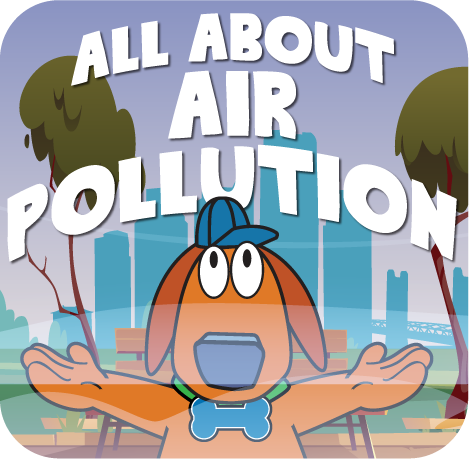Air pollution occurs when things like gases, dust particles or smoke are released into the atmosphere and make the air harmful to people, animals, and the planet. Air pollution can increase the risk of serious health problems including:
- Respiratory illness
- Asthma
- Coughing
- Wheezing
- Watery eyes
- Chest pain
- Difficulty fighting infection
- Unusually tired
- Dizziness
- Heart attack
Ground-level ozone and particulate matter are the two most common types of air pollution.
WHAT IS GROUND-LEVEL OZONE?
Ozone is a colorless gas, which forms the ozone layer high up in the atmosphere above earth. This ozone layer is a shield that protects us from the sun’s harmful ultraviolet (UV) rays. But down where we live and breathe, it’s harmful. This is called ground-level ozone, or smog.
Smog is one of the most common types of air pollution, especially in the summer. Smog is unhealthy to breathe. About 70 percent of the Sacramento region’s ozone problem is caused by gas-powered vehicles, including trucks, buses, agricultural and construction equipment, along with gas-powered lawn and garden tools. Those things produce NOx (oxides of nitrogen) and VOCs (volatile organic compounds) that react in the sunlight to form ozone pollution.
Here’s how smog is made:


When “NOx” and “VOCs” come together and react with the light from the sun, they create smog, which pollutes the air we breathe!
VOCs come from:
- Gasoline
- Paint fumes
- Charcoal lighter fluid
- Hair spray
- Furniture polishes
NOx can come from gas-powered vehicles and equipment as well as some types of industry such as:
- Cars
- Trucks
- Buses
- Construction equipment
- Farm equipment
- Lawn and gardening equipment
- Power plants and factories


NOx can come from gas-powered vehicles and equipment as well as some types of industry such as:
- Cars
- Trucks
- Buses
- Construction equipment
- Farm equipment
- Lawn and gardening equipment
- Power plants and factories
Why is smog a problem?
When temperature inversions occur (that is, when warm air stays near the ground instead of rising) and the wind is calm, smog may remain trapped over a city for days. As traffic and other sources add more pollutants to the air, the smog gets worse. Smog is often more severe farther away from the sources of pollution because the chemical reactions that cause smog take place in the atmosphere while pollutants are drifting in the wind.
Smog is unhealthy for you to breathe. It can affect your lungs and your heart. It’s even worse for younger kids, because your lungs are still developing, as well as pregnant women, the elderly and people who have lung diseases such as asthma or bronchitis.

WHAT CAN I DO TO HELP REDUCE SMOG?
You can help us reduce air pollution. Here’s how!
- Find ways to reduce the number of car trips your family takes. Carpool to school with friends, ask your parents to do all their errands in one trip.
- Take public transit when you can.
- Turn off lights and electronics when you’re not using them. This saves energy and burns less fuel at power plants.
- Buy food from a farmers’ market. If your food is traveling a short distance to get to you (or your local store), fewer gas emissions are created.
- Plant a tree. Trees absorb ozone and other greenhouse gases.
WHAT IS PARTICULATE MATTER?
Particulate matter, also called PM2.5, is what we call very small particles that are released into the air from vehicles, factories, and smoke from wildfires, campfires, and wood-burning devices.
PM2.5 is one of the most common types of air pollution, especially in the winter. It is often made up of a mixture of smoke, dust, tire rubber or other pollutants. PM2.5 is unhealthy to breathe.
While Spare The Air is a program to reduce smog, there are other programs to help reduce PM2.5 in the winter. Remind your parents to always check with your local air district before lighting a fire during the winter months.









